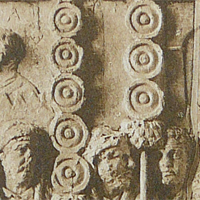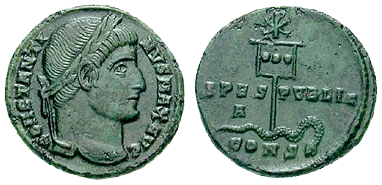
This page created 8 September 2014, and last modified: 23 September 2015 (Legio III Gallica commentary added)

The Honoriani felices Gallicani is listed (98/9.121 in Ingo Maier's numbering scheme) as 24th of the 32 units of legiones comitatenses in the Magister Peditum's infantry roster; it is assigned (102/5.141) to the Magister Equitum's Gallic command. Its shield pattern (96#14) as shown in various manuscripts, under the simple label (96.o) Gallicani, is as below:

The shield pattern has a red rim; the main field is green (but faded to yellow in M); the boss is also green (but white in B, yellow in M). Above and below the boss are two white discs, very slightly smaller than the boss, and (except in B) tangential to it. No other shield pattern in the Notitia has such a triple-disc arrangement. Given the indications that many other shield patterns may show unit standards, the vertical arrangement here calls to mind infantry signa (standards) and their philarae such as shown below on standards depicted on Trajan's column.

Nonetheless, the discs might be thought unlikely to represent such a standard, because they were carried by centuries, likely too small a unit to have given rise to an independent vexillatio (the latin word which means both "banner/standard" and "unit"). The standard of an entire legion was of course the aquila or Eagle, at least in the Principate, and which would not be borne by a mere detachment (unless the detachment in question was eventually recognised as a legion in its own right, and thus given its own eagle), and the intermediate unit, the cohort, is not known to have had a standard at all, until Vegetius, roughly contemporary with the Notitia, mentions cohorts having a draconarius - a standard bearer who carried a draco, which was a windsock-type standard, rather than an arrangement of discs on a pole. Still, not enough is known about late imperial Roman standards to dismiss this possibility.
Another image of three discs that springs to mind is the famous Constantinian "labarum" standard coin; apparently the first issued (in 326) to definitely contain a Christian motif; the Chi-rho monogram above the flag.

The three discs have been interpreted as representing portraits of Constantine and his two consular sons, the future Constantine II and Constantius II (e.g. C. Odahl, 1975, An Eschatological Interpretation of Constantine's Labarum Coin, available here here), since Eusebius describes (Life of Constantine, 31) the labarum as portraying the emperor and his children from the chest upwards, albeit the portrait apparently being above the banner portion of the standard. Of course the coin has the discs arranged horizontally, rather than vertically...
The name Honoriani refers to the emperor Honorius, who succeeded his father Theodosius I in 395, around the time the Notitia was first compiled. Note that Honorius had however, been declared co-Augustus two years earlier, at the age of 7, so the presence of units bearing the name Honorius does not therefore prove they must have been entered into the document so-named at 395 at the earliest. Nonetheless, the presence of large numbers of units in the western half of the Notitia named after Honorius, compared to very few in the east, is one of the clearest indications the eastern portion was not amended much, or even at all, after the death of Theodosius, while the western half was extensively updated.
Felices usually means "fortunate" or "lucky", and was a common moniker for Roman units (it also has another meaning of "fruitful", which is less likely to have a military association); over twenty units in the Notitia incorporate are credited with the name. It is notable, however, that the Honoriani felices Gallicani is one of only two that are listed as being legionary units (the other is the Secunda Felix Valentis Thebaeorum (15.23), under the Magister Militum per Orientem).
The name Gallicani refers to Gaul; presumably the unit was either raised there, or had been serving there, perhaps as a limitanei unit, before joining the field army. A potential candidate for a unit being stationed there is what in the Notitia is listed as the plain Legio quarta Flavia (78.20), a limitanei legion under the Dux Moesiae primae, based at Singidunum (modern Belgrade), which is known to have the name Legio IIII Flavia Felix in full. Detachments of this unit are known to have served in many regions. For example, coinage indicates a detachment likely served in Gaul during the reign of the Gallic Emperor Victorinus (269 - 271), as he issued a gold coin inscribed LEG IIII FLAVIA P F, which expands to "Legio IIII Flavia Felix Pia Fidelis". If so, this would indicate that Honorius did not found the unit, but merely re-founded it, in much the same way as the "original" Legio IIII Flavia Felix was not actually founded in the year 70, but refounded, mostly from soldiers of the former Legio IIII Macedonica that had been disbanded earlier in the year. Indeed, the position of the unit in the Magister Peditum's roster implies it had been in the field army a reasonable amount of time when the Notita was complied, as it comes before a string of five "Flavian" legions, which cannot have been raised before the early 4th century.
However, it must be pointed out that many other units could also be candidate progenitors of the Honoriani felices Gallicani (it is not, after all, certain Victorinus' Legio IIII detachment was even in Gaul when it was commemorated by his coinage, for the coin in question actually depicts a personification of Africa). Indeed, a much better candidate is Legio III Gallica, which is attested in the Notitia (63.15) as being stationed at Danaba under the Dux Foenicis. As this legion was founded by Julius Caesar, it would have been strange if it had spawned no detachments in the 450-odd years since, and the Honoriani felices Gallicani, along with the Lanciarii Gallicani Honoriani (98/9.113), are by far the best candidates.

Return to the Notitia alphabetical unit list page.
Return to my Notitia index page.